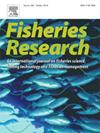Refining size selection in an Australian whiting (Sillago spp.) boat seine
IF 2.2
2区 农林科学
Q2 FISHERIES
引用次数: 0
Abstract
As part of an initiative to assess boat seining for harvesting eastern school (Sillago flindersi) and stout whiting (S. robusta) off New South Wales, Australia, two experiments were done to determine if changing the orientation and sizes of codend meshes reduced catches of immature (<17 cm total length; TL) individuals. The control codend comprised 37-mm diamond-shaped (T0) mesh throughout, and was alternately deployed against two codends with the same twine diameter and length, but comprising: (1) a 2-m cylinder of 40-mm mesh turned 90° (T90) attached to 46-mm T0 mesh (termed the ‘40/46-mm T90/T0 codend’) in experiment 1; and (2) 46-mm T0 mesh throughout (‘46-mm T0’) in experiment 2. During 90 deployments, 201 t was caught: 145 t (72 %) of whiting, 2 t of other retained catches, and 54 t (27 %) of discards. Both larger-meshed codends caught fewer small and mature eastern school whiting, but with no overall significant differences in size selection to the control codend. Conversely, there was a difference for stout whiting, with fewer small fish, but not mature individuals, escaping the 46-mm T0 codend. Retained octopus (Octopus spp.) catches were lower in the larger-meshed codends, but there were no significant effects on discarded species. Few whiting were impinged in T0 meshes, whereas up to 17 % (mature fish) in the 40/46-mm T90/T0 codend were secured in the T90 meshes. The data reiterate the utility of boat seining for targeting whiting with minimal bycatch—within which size selection might be controlled via a T0 codend comprising ∼40–47 mm throughout.
澳大利亚白鲸(西拉戈种)渔船围网的细化尺寸选择
作为评估渔船围网在澳大利亚新南威尔士州捕获东部白鲟(Sillago flindersi)和黑体白鲟(S. robusta)的举措的一部分,进行了两项实验,以确定改变网的方向和大小是否会减少未成熟白鲟(总长度为17 厘米;TL)人。对照线端由37-mm菱形(T0)网组成,并交替部署在具有相同线径和长度的两个线端上,但包括:(1)在实验1中,一个2米的40-mm网筒旋转90°(T90),连接到46-mm T0网(称为“40/46-mm T90/T0线端”);(2)实验2中46-mm T0孔贯穿(' 46-mm T0 ')。在90次部署中,捕获了201 吨:145吨(72 %)的白鱼,2 吨的其他保留渔获,54 吨(27 %)的废弃渔获。大网目鱼种捕获的小而成熟的东部鱼群较少,但在鱼种大小选择上与对照鱼种总体上没有显著差异。相反,粗白鲸的情况有所不同,小鱼较少,但没有成熟的个体,逃脱了46毫米的T0代码。大网目鱼种的保留章鱼捕获量较低,但对丢弃鱼种的影响不显著。在T0目中,很少有白鱼被撞击,而在40/46 mm T90/T0目中,高达17 %(成熟鱼)被撞击在T90目中。数据重申了渔船围网的效用,以最小的副渔获物为目标,其中尺寸选择可以通过T0代码控制,整个代码包括~ 40-47 mm。
本文章由计算机程序翻译,如有差异,请以英文原文为准。
求助全文
约1分钟内获得全文
求助全文
来源期刊

Fisheries Research
农林科学-渔业
CiteScore
4.50
自引率
16.70%
发文量
294
审稿时长
15 weeks
期刊介绍:
This journal provides an international forum for the publication of papers in the areas of fisheries science, fishing technology, fisheries management and relevant socio-economics. The scope covers fisheries in salt, brackish and freshwater systems, and all aspects of associated ecology, environmental aspects of fisheries, and economics. Both theoretical and practical papers are acceptable, including laboratory and field experimental studies relevant to fisheries. Papers on the conservation of exploitable living resources are welcome. Review and Viewpoint articles are also published. As the specified areas inevitably impinge on and interrelate with each other, the approach of the journal is multidisciplinary, and authors are encouraged to emphasise the relevance of their own work to that of other disciplines. The journal is intended for fisheries scientists, biological oceanographers, gear technologists, economists, managers, administrators, policy makers and legislators.
 求助内容:
求助内容: 应助结果提醒方式:
应助结果提醒方式:


